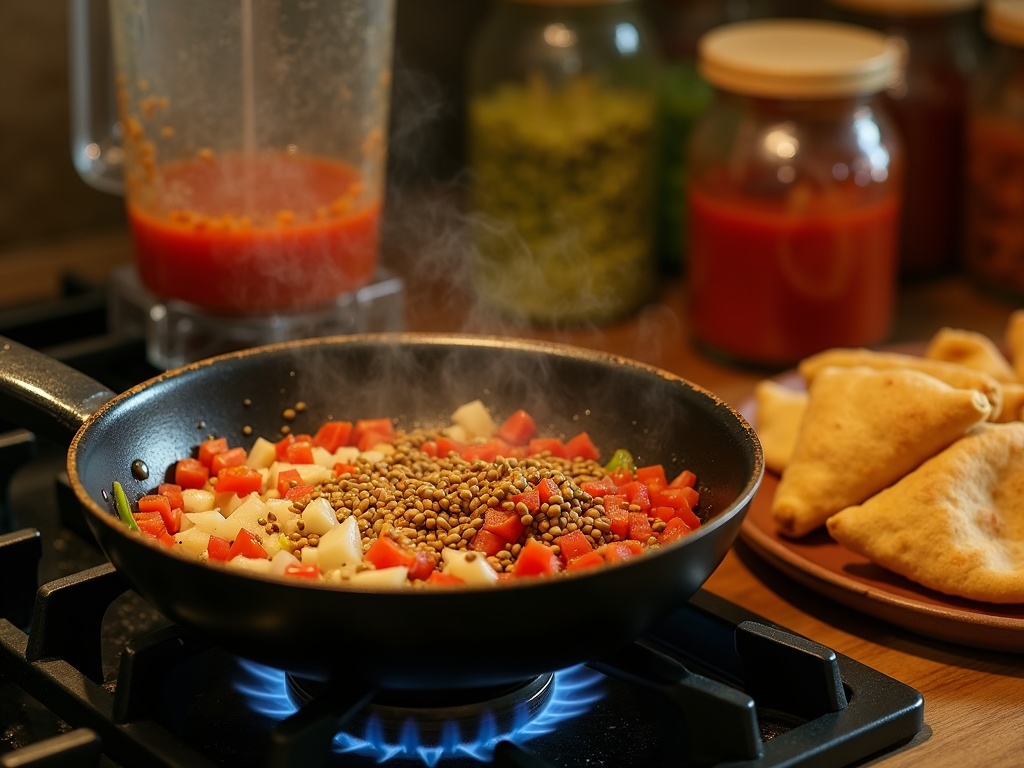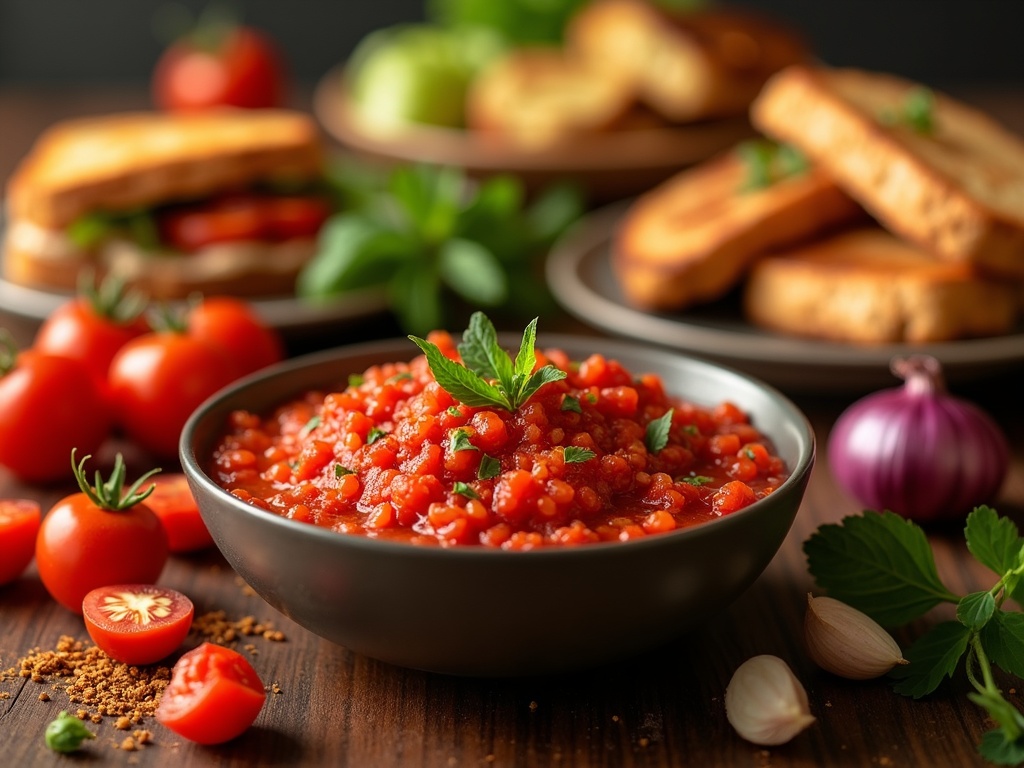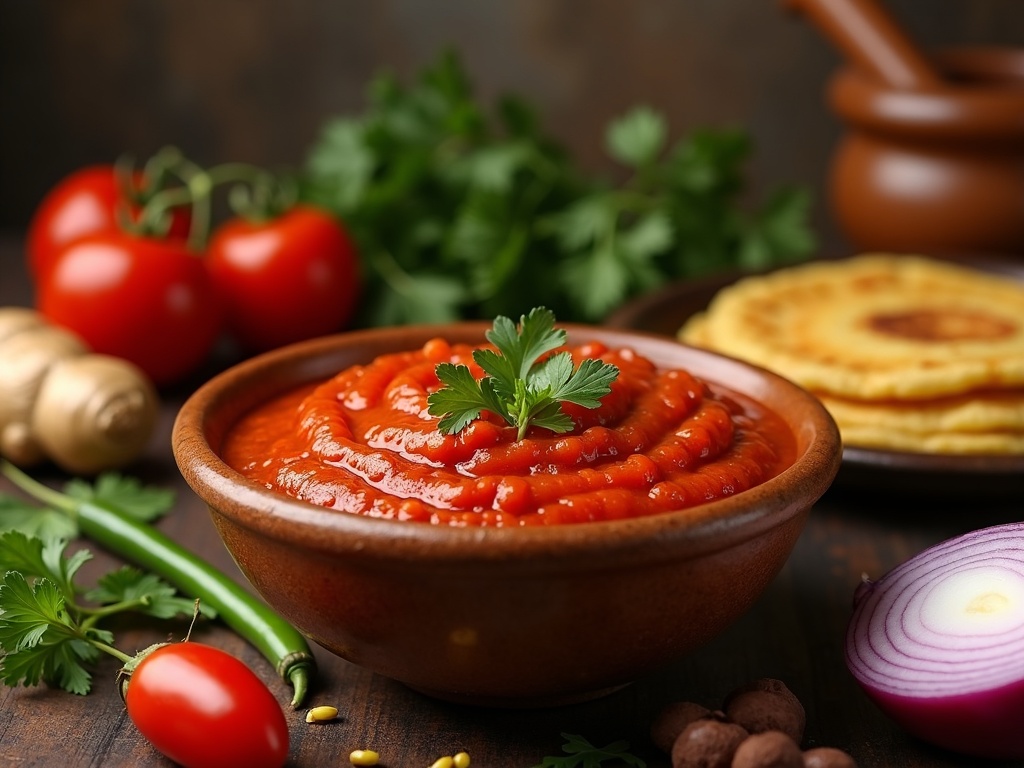Tomato chutney recipe has transformed from a traditional Indian condiment into a global sensation valued at $1.1 billion in 2021, with projected growth of 6.4% through 2030. This versatile sauce elevates everyday meals with its balanced tangy, sweet, and spicy flavors that enhance everything from South Indian classics like dosas and idlis to sandwiches, grilled proteins, and snacks.
Find In This Article
Key Takeaways
- The recipe needs basic ingredients including ripe tomatoes, onions, green chilies, ginger, and mustard seeds, totaling about 200 calories per batch.
- Preparation starts with tempering mustard seeds in oil, cooking onions until translucent, and simmering tomatoes with spices for 10-15 minutes before blending to your preferred texture.
- Tomato chutney delivers nutrients including vitamins C, K, and A, plus lycopene, an antioxidant that becomes more effective when cooked.
- This condiment remains fresh for up to two weeks when kept in airtight containers in the refrigerator.
- Beyond Indian pairings, tomato chutney serves perfectly as a sandwich spread, dipping sauce, and complement to grilled meats and vegetables.
Why Tomato Chutney is a Must-Try Condiment
Tomato chutney holds a special place in my kitchen, and for good reason. This vibrant condiment has grown tremendously in popularity around the world, with the global chutney market valued at $1.1 billion in 2021. That’s not surprising given its incredible versatility and flavor profile. What’s more impressive is the projected growth rate of 6.4% from 2022 to 2030, showing just how many people are discovering this delicious addition to their meals.
Versatility That Elevates Every Meal
I’ve found that tomato chutney recipe transforms ordinary dishes into extraordinary culinary experiences. Its tangy, sweet, and spicy notes create the perfect balance that complements a wide range of foods. This adaptability makes it an essential condiment in my kitchen.
The beauty of tomato chutney lies in its ability to pair with almost anything:
- South Indian favorites: It’s the perfect companion for crispy dosas, fluffy idlis, and savory vadas
- Everyday meals: Adds zing to sandwiches, wraps, and toast
- Protein dishes: Enhances grilled chicken, fish, or paneer
- Snacks: Transforms simple appetizers like samosas or pakoras
- Rice dishes: Brings plain rice to life with just a spoonful
I particularly love how homemade chutney allows for personalization. You can adjust the spice level, sweetness, or tanginess based on your preference. The core ingredients remain simple – ripe tomatoes, spices, and sometimes a touch of sweetness – but the variations are endless.
The rising popularity of tomato chutney outside its traditional Indian roots speaks to its universal appeal. It’s no longer just a staple in Indian cuisine but has found its way into international kitchens, fusion restaurants, and gourmet food stores. This growth reflects how this humble condiment has captured the hearts (and palates) of food lovers globally.
What makes tomato chutney particularly appealing is its ability to balance flavors. The natural acidity of tomatoes creates the perfect base for both sweet and savory interpretations. The tanginess cuts through rich foods, the spice adds dimension, and the slight sweetness rounds everything out perfectly.
Fresh Ingredients for the Perfect Chutney
Creating a delicious tomato chutney starts with selecting the finest ingredients. I’ve found that the quality of your produce directly impacts the flavor profile of the final dish.
Core Ingredients
The heart of any good chutney recipe lies in its fresh components. For this tomato chutney, you’ll need 4 medium ripe tomatoes, which contribute about 88 calories to the dish. Look for tomatoes that are bright red, firm but with a slight give when pressed, and fragrant at the stem. These indicators suggest peak ripeness and maximum flavor.
A single onion (adding approximately 44 calories) provides the essential base note. Choose a fresh onion with dry, papery skin and no soft spots. For the heat element, include 2-3 green chilies, which add just 5-10 calories while bringing significant flavor impact.
Fresh ginger (about 1 teaspoon, adding merely 2 calories) delivers that distinctive warm, spicy note that elevates the chutney. Always use fresh ginger rather than powdered for authentic taste.
The spice foundation comes from 1-2 teaspoons of mustard seeds, which not only add flavor but create that satisfying pop when they hit hot oil. Speaking of which, you’ll need 2 teaspoons of oil (80 calories) to temper the spices properly.
Salt is essential for balancing the flavors, and for a fresh finishing touch, consider adding coriander leaves as an optional garnish.
Preparation Tips
The entire recipe comes in at approximately 200 calories, making it a light accompaniment to many meals. Here are some tips for working with these ingredients:
- Blanch tomatoes in hot water for 30 seconds to make peeling easier
- Dice onions finely for quicker cooking and better texture
- Adjust the number of chilies based on your heat preference
- Use a mortar and pestle for crushing ginger to release more flavor
- Toast mustard seeds until they pop for maximum aroma
I’ve noticed that spending extra time selecting quality ingredients pays dividends in the final taste. Ripe tomatoes particularly make the difference between an ordinary chutney and an exceptional one.

Simple Steps to Make Your Chutney
I start my tomato chutney journey with a hot pan and some quality oil. The magic begins when the mustard seeds hit the hot surface—they dance and pop in just about a minute, releasing their nutty aroma. This simple step sets the foundation for a flavorful homemade chutney that’ll transform your meals.
Next, I add finely chopped onions to the popping seeds. The key here is patience—I sauté them for 3-4 minutes until they become soft and translucent. This brings out their natural sweetness, which balances perfectly with the tanginess of tomatoes.
The heart of any tomato chutney recipe is, of course, the tomatoes themselves. I add chopped tomatoes, green chilies, and grated ginger to the pan, along with a pinch of salt. This mixture needs to cook for 10-15 minutes, during which I stir occasionally. The tomatoes break down, releasing their juices and creating a thick, bubbling mixture that smells divine.
The Final Touches
After cooking, I let the mixture cool slightly before transferring it to a blender. A few quick pulses transform it into a smooth paste—though if you prefer a chunkier texture, you can blend it less. I’ve found that different consistencies work better for different pairings:
- Smooth paste pairs wonderfully with crispy snacks and flatbreads
- Slightly chunky texture adds character to sandwiches and wraps
- Coarsely blended chutney makes an excellent dipping sauce for fritters and samosas
Once blended to your desired consistency, the chutney needs to cool completely before being transferred to clean, airtight containers. Properly stored in the refrigerator, this chutney stays fresh for up to 2 weeks—though it rarely lasts that long in my house!
I’ve discovered that the slow cooking technique intensifies the flavors in this chutney. The longer the tomatoes cook, the deeper and more complex the flavor becomes. This slow reduction concentrates the natural sugars in the tomatoes, creating a perfect balance of sweet, tangy, and spicy notes.
For an extra dimension of flavor, I sometimes add a tempering of cumin seeds and dried red chilies at the very end. The sizzling spices infuse the chutney with aromatic warmth that’s simply irresistible.
The beauty of this recipe lies in its simplicity. With just a handful of ingredients and about 20 minutes of active cooking time, I can create a versatile condiment that elevates everything from simple rice dishes to grilled meats and vegetables.
Don’t be afraid to adjust the spice levels to suit your taste—chutney is forgiving that way. Add more chilies for heat or a touch of jaggery for sweetness if the tomatoes aren’t quite ripe enough. The recipe becomes your own as you make these small adjustments.
Each batch I make turns out slightly different, reflecting the natural variation in ingredients. This keeps things interesting and makes each jar a unique creation. The process of making chutney has become a meditative ritual in my kitchen—the rhythmic chopping, the aromatic simmering, and finally, the satisfaction of bottling up something delicious made from scratch.

Health Benefits and Nutritional Value
I love adding tomato chutney to meals not just for its vibrant flavor, but also for the impressive health benefits it delivers. This delicious condiment packs a nutritional punch that might surprise you.
Vitamin and Mineral Content
Tomatoes form the foundation of this chutney, bringing a wealth of essential nutrients to the table. Each serving contains impressive amounts of vitamins C, K, and A, all of which play vital roles in maintaining overall health. Vitamin C strengthens your immune system and helps with collagen production for healthy skin. Vitamin K supports proper blood clotting and bone health, while vitamin A promotes good vision and cell growth.
The nutritional benefits don’t stop there. Tomato chutney also provides important minerals including:
- Potassium, which helps regulate fluid balance, muscle contractions, and nerve signals
- Folate (vitamin B9), essential for cell function and tissue growth, particularly important during pregnancy
- Trace amounts of iron, calcium, and magnesium that contribute to overall health
Perhaps the most significant nutritional benefit comes from lycopene, a powerful antioxidant that gives tomatoes their red color. This compound helps protect cells from damage by neutralizing harmful free radicals in the body. Interestingly, cooking tomatoes actually increases the bioavailability of lycopene, making chutney an excellent way to consume this beneficial compound.
For those watching their calorie intake, tomato chutney offers a flavorful option that won’t derail your healthy eating goals. A standard 2-tablespoon serving contains approximately 25 calories, making it a smart choice compared to many other condiments that can be calorie-dense.
The fiber content shouldn’t be overlooked either. Each serving provides about 1g of dietary fiber, which may seem modest but contributes to your daily intake requirements. Fiber aids digestion, helps maintain bowel health, and can assist with blood sugar control.
Research has consistently shown connections between tomato consumption and reduced risk of certain health conditions. Regular intake of lycopene-rich foods like tomato chutney has been associated with lower rates of heart disease. The antioxidant properties help reduce inflammation and may prevent the oxidation of cholesterol, which contributes to plaque formation in arteries.
Additionally, studies have linked lycopene consumption to decreased risk of certain cancers, particularly prostate cancer in men. The combination of antioxidants and other phytonutrients in tomatoes creates a protective effect that supports overall cellular health.
For people managing their blood pressure, the potassium content in tomato chutney offers additional benefits. Potassium helps counteract the effects of sodium, potentially helping to lower blood pressure in some individuals.
I find that incorporating tomato chutney into meals provides an easy way to boost nutrition without sacrificing flavor. Whether spread on whole grain toast, paired with grilled chicken, or used as a dipping sauce for vegetables, it adds both taste and valuable nutrients to ordinary dishes.
The balance of sweet, sour, and savory notes in tomato chutney makes it an incredibly versatile condiment that can enhance almost any meal while simultaneously contributing to your daily nutrient intake.

Delicious Ways to Enjoy Your Chutney
I’ve discovered countless ways to incorporate tomato chutney into meals beyond its traditional uses. This versatile condiment adds a burst of flavor to almost any dish with its perfect balance of tangy, sweet, and spicy notes.
Perfect Pairings for Every Meal
Tomato chutney shines brightest alongside South Indian cuisine. The tangy flavor perfectly complements the subtle taste of dosas (crispy rice crepes), acting as a zesty counterpoint to their mild flavor. With soft, steamed idlis, the chutney adds a welcome punch that transforms this simple dish into something extraordinary. For uttapams (savory pancakes), I find that a generous dollop of chutney cuts through the richness beautifully.
Beyond Indian cuisine, this versatile condiment works wonders as a spread for sandwiches and burgers, replacing mayo or ketchup with a more complex flavor profile. I’ve found it pairs exceptionally well with grilled meats and vegetables, adding moisture and tanginess to chicken, fish, or grilled eggplant.
For casual snacking, tomato chutney makes an outstanding dipping sauce. Try it with:
- Crispy potato chips for an elevated snack experience
- Fresh cucumber and carrot sticks for a healthy option
- Samosas or pakoras for an authentic Indian treat
- Grilled cheese sandwiches for a flavor-packed dunk
Regional Variations and Creative Twists
The beauty of chutney recipes lies in their regional diversity. South Indian versions often incorporate fresh coconut for a subtle sweetness and cooling effect, creating a more delicate profile. Northern Indian preparations tend to feature bolder spices like fenugreek seeds or asafoetida, resulting in a more robust flavor.
I like to experiment with creative additions that transform the basic recipe. Roasted red peppers add smoky sweetness, while extra garlic intensifies the savory notes. For those with a sweet tooth, incorporating jaggery (unrefined cane sugar) instead of regular sugar creates a deeper caramel undertone.
What makes tomato chutney truly special is its adaptability. The basic recipe serves as a canvas for personal expression – adding a handful of mint leaves for freshness or a squeeze of lime for extra tanginess completely transforms the character of this condiment. Whether you prefer it chunky or smooth, mild or fiery, there’s a tomato chutney variation that will complement your favorite foods perfectly.

Sources:
Global Chutney Market Analysis, 2021-2030
Nutritional Data on Tomatoes from the USDA FoodData Central
Various culinary blogs on Indian cuisine and chutney recipes

